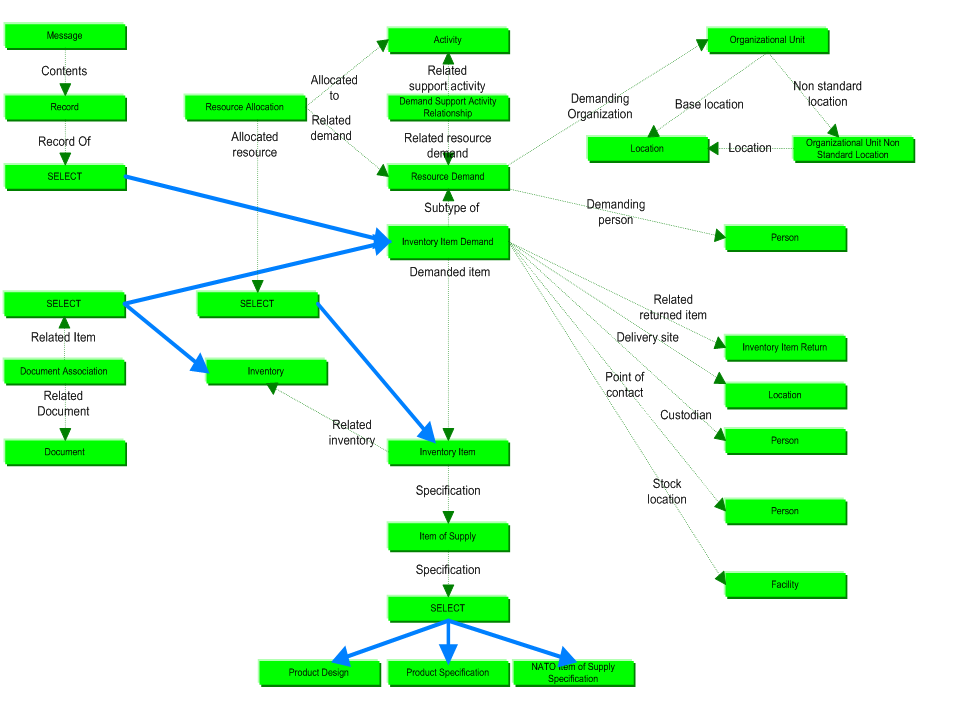
| Business DEX (UK_Defence043):— inventory_item_demand | Date: 2009/11/06 17:30:44 Revision: 1.25 |
The information requirements table for the Inventory Item Demand DEX and corresponding business objects are provided below:
|
Information requirement |
Business Object(s) |
|---|---|
| Information that is used to define the message that performs the inventory item demand UK_Defence processes. | Message, Record. |
| All MoD inventory items used to support the related PSE, not just serialised items | Inventory Item, Item of Supply, Product Design, Product Specification, NATO Item of Supply Specification |
| Identification of the demand. | Resource Demand, Inventory Item Demand |
| Identification of the organization demanding the item. | Resource Demand, Inventory Item Demand, Organizational Unit, Location, Organizational Unit Non Standard Location |
| Identification of the person demanding the item. | Resource Demand, Inventory Item Demand, Person |
| Identification of the item demanded by reference codes. | Inventory Item, Inventory, Item of Supply, Product Design, Product Specification, NATO Item of Supply Specification |
| If item references are not known, it may be demanded by description or reference to documentation. | Inventory Item, Inventory, Document Association, Document |
| Identification of the item by name (usually Short Item Name). | Inventory Item, Item of Supply, Product Design, Product Specification |
| Quantity and denomination of items required. | Inventory Item Demand, Resource Demand, Activity, Demand Support Activity Relationship |
| Qualifications of whether alternative items of supply or reduced numbers of items are acceptable for delivery or not. | Inventory Item Demand, Resource Demand, Activity, Demand Support Activity Relationship |
| Identification of where stock may be held and/or who the custodian will be. | Inventory Item Demand, Facility, Person |
| Date demand raised. | Resource Demand, Resource Allocation |
| Required Delivery Date (RDD). | Inventory Item Demand, Resource Demand, Resource Allocation |
| Location to be delivered to. | Inventory Item Demand, Location |
| Authority to demand. | Inventory Item Demand, Resource Demand, Resource Allocation |
| Identification of any special requirements, including Justification of Airfreight (For all items not normally warranting movement by air). | Inventory Item Demand, Resource Demand, Resource Allocation, Activity, Demand Support Activity Relationship |
| Priority of the demand (using the Standard Priority Code from JSP 886). | Inventory Item Demand, Resource Demand, Resource Allocation, Activity, Demand Support Activity Relationship |
| Activity to which demand is related or Reason for Demand (RFD) e.g. to replenish stocks. | Inventory Item Demand, Resource Demand, Resource Allocation, Activity, Demand Support Activity Relationship |
| Accounting information e.g. Unit Identification Number (UIN). | Inventory Item Demand, Resource Demand, Organizational Unit, Location, Organizational Unit Non Standard Location |
| Identification of the theatre to which the item is to be supplied (by Theatre Code). | Inventory Item Demand, Location |
| Supplementary information for service specific Supply Chain Management: for example Customer Reference. | Inventory Item Demand, Resource Demand, Organizational Unit, Location, Organizational Unit Non Standard Location |
| Secondary Depot Code (Army Use). | Inventory Item Demand, Resource Demand, Organizational Unit, Location, Organizational Unit Non Standard Location |
| Point of contact for queries. | Inventory Item Demand, Person |
| Request for full despatch/flight details and Airway Bill (AWB) numbers as required. | Inventory Item Demand, Resource Demand, Resource Allocation |
| Remarks to allow for supplementary information. | Inventory Item Demand, Resource Demand, Resource Allocation |
| Condemnation codes for permanent items. (e.g. Army AFG1043 or RAF F731) . | Inventory Item Demand, Resource Demand, Resource Allocation |
Table 1 — Inventory Item Demand information requirements
In terms of business objects, these information requirements are modelled as shown below in Figure 1.
NOTE For clarity, not all of the dependent business objects - those that will make the model referentially complete - have been included on the diagram.

© UK MOD 2010 — All rights reserved